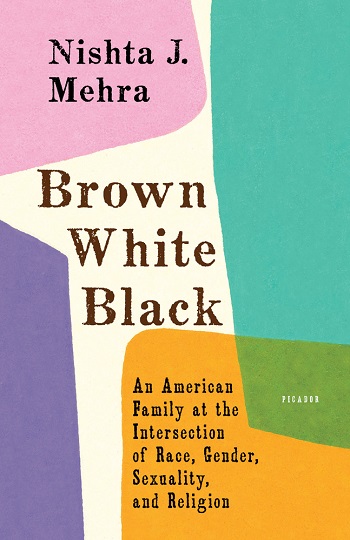Sandwiched between whiteness and blackness, being brown in the U.S. has always been uncomfortable. During the early 1900s, the American judiciary waffled back-and-forth on the racial classifications of Indian Americans. In some cases, the Indian American was classified as “white”; in some other cases, as “colored.” Although that specific legal history is now long past, the uneasy relationship of brownness with its counterparts still persists.

In Brown White Black: An American Family at the Intersection of Race, Gender, Sexuality, and Religion (Picador), Nishta J. Mehra engages with this discomfort directly. The essay collection brings to life Mehra’s experience at the intersections of race, gender, sexuality, and religion. She weaves an intimate portrait of her family — of her wife, who is white, and of her son Shiv, who is black.
The essays veer between past and present, examining her childhood in racially divided Memphis; coming out as queer; navigating her father’s death and his earlier rejection of Mehra’s sexuality; and figuring out how to protect her child while simultaneously educating him on the sharp realities of being black in America. She bemoans being the token queer couple for some people she knows, rages at the myriad of ways society centers heterosexuality as the parenting default, and reflects on her experiences with queer adoption.
Mehra is unflinching in interrogating brownness in the context of whiteness, describing her own experience with respectability politics at a wealthy, white parochial school. “[M]y yearbook superlative was ‘All-American Ethnic Girl.’ And the worst part is, I’m the one who came up with it,” confesses Mehra in the collection’s opening essay.
She is also honest and matter-of-fact in interrogating brownness in the context of blackness, particularly critiquing anti-blackness in the Indian community. In the essay, “Pretending To Be White,” Mehra turns her critical lens inward: She describes how she internalized the “tastes and manners” of the white culture surrounding her at school, the uncertainty she felt engaging with her parents’ black colleagues, and her desire to be the “right” kind of immigrant.
The essays continue to gain their rhythm as Mehra explores the challenges and opportunities of parenting a gender-creative child who is black. Shiv adores dancing, crafting elaborate outfits, and wearing a t-shirt as “hair.” Her wonder as she learns from and alongside Shiv is tender and thoughtful, and the fear she experiences in thinking about how to protect him is all too real.
“[I] never considered that I’d possibly need to let go of my attachment to Shiv’s gender,” writes Mehra in the essay, “(Not) Passing.” “[T]hough not quite as blindsided as my parents were when I came out to them, I, too, have been surprised by an aspect of my child’s identity that I hadn’t seen coming.” Since the book went to press, Shiv now uses “she” and “her” pronouns.
There are moments that call for greater detail, specifically how Mehra understood her queer identity in high school and the later implications for her interracial relationship. There are other moments where the writing feels more academic, like a primer for an audience who might not have exposure to the multiple intersections explored throughout the collection. And, given the glut of think pieces in the last few years, the collection would have been just as vibrant without examining “Starbucks names” and cultural appropriation of the bindi.
It would be a disservice to all of us, though, to write off Brown White Black for these minor critiques. Nishta Mehra has a singular voice, one that is fierce, clear, and candid. This book is another guidepost for those of us who are queer and brown and born in the United States.
***
Nina Bhattacharya is a writer, visual artist, and educator based in Cambridge, MA. Find her at @radio.rani and listen to her on the Almirah Radio Hour.












